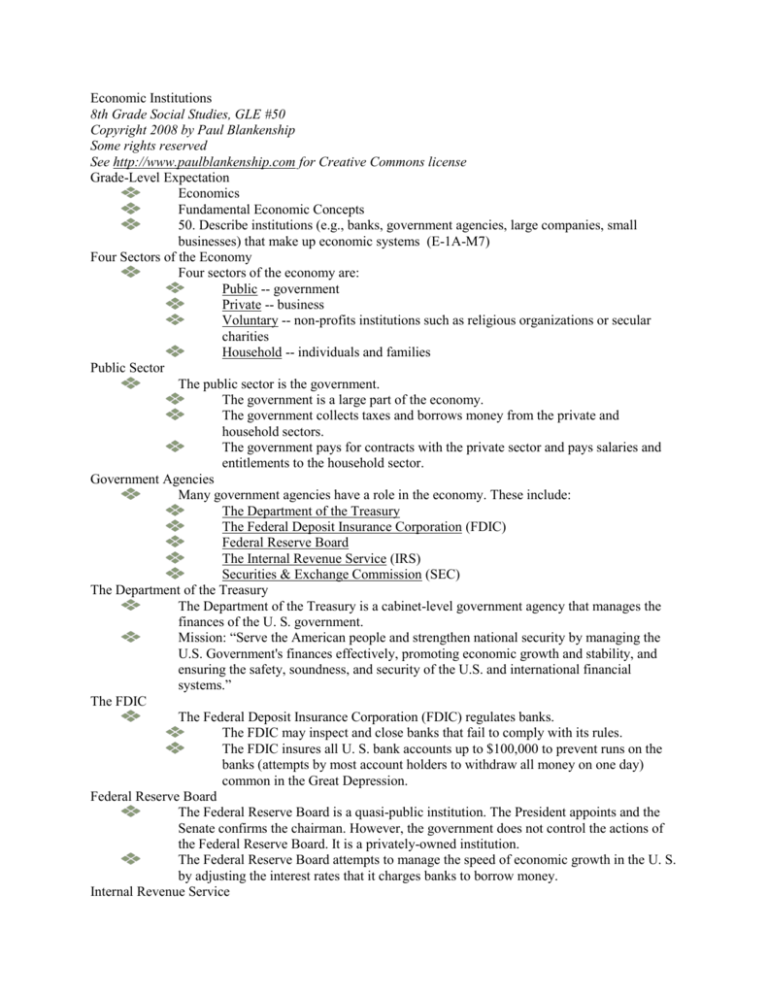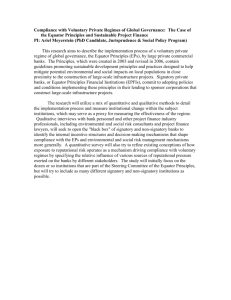
Economic Institutions
8th Grade Social Studies, GLE #50
Copyright 2008 by Paul Blankenship
Some rights reserved
See http://www.paulblankenship.com for Creative Commons license
Grade-Level Expectation
Economics
Fundamental Economic Concepts
50. Describe institutions (e.g., banks, government agencies, large companies, small
businesses) that make up economic systems (E-1A-M7)
Four Sectors of the Economy
Four sectors of the economy are:
Public -- government
Private -- business
Voluntary -- non-profits institutions such as religious organizations or secular
charities
Household -- individuals and families
Public Sector
The public sector is the government.
The government is a large part of the economy.
The government collects taxes and borrows money from the private and
household sectors.
The government pays for contracts with the private sector and pays salaries and
entitlements to the household sector.
Government Agencies
Many government agencies have a role in the economy. These include:
The Department of the Treasury
The Federal Deposit Insurance Corporation (FDIC)
Federal Reserve Board
The Internal Revenue Service (IRS)
Securities & Exchange Commission (SEC)
The Department of the Treasury
The Department of the Treasury is a cabinet-level government agency that manages the
finances of the U. S. government.
Mission: “Serve the American people and strengthen national security by managing the
U.S. Government's finances effectively, promoting economic growth and stability, and
ensuring the safety, soundness, and security of the U.S. and international financial
systems.”
The FDIC
The Federal Deposit Insurance Corporation (FDIC) regulates banks.
The FDIC may inspect and close banks that fail to comply with its rules.
The FDIC insures all U. S. bank accounts up to $100,000 to prevent runs on the
banks (attempts by most account holders to withdraw all money on one day)
common in the Great Depression.
Federal Reserve Board
The Federal Reserve Board is a quasi-public institution. The President appoints and the
Senate confirms the chairman. However, the government does not control the actions of
the Federal Reserve Board. It is a privately-owned institution.
The Federal Reserve Board attempts to manage the speed of economic growth in the U. S.
by adjusting the interest rates that it charges banks to borrow money.
Internal Revenue Service
The Internal Revenue Service (IRS) collects taxes for the federal government in the
United States.
The IRS has broad powers to investigate and arrest those suspected of tax fraud.
The SEC
Securities and Exchange Commission
Regulates the sale of stocks and other financial instruments in the United States
Protects investors from fraud
Maintains the integrity of the stock and commodity exchanges
The Private Sector
The Private Sector includes for-profit businesses from small family-operated stores to
multinational corporations.
The Private Sector is the engine that powers the economy.
Private and Public Sector institutions are divided into the primary, secondary, and tertiary
sectors of industry.
Primary Sector of Industry
The primary sector of industry involves the gathering or extraction of natural resources.
Divisions include:
Genetic Industries
Extractive Industries
Genetic Industries
Industries that produce materials with genes are the genetic industries. These include:
Farming
Fishing
Logging
Do not confuse this with genetic engineering. Most genetic industries still do without
genetically modified organisms (GMOs).
Farms and Agribusiness
Farms, ranches, and related businesses are called “agribusinesses.”
These private sector institutions provide food, fiber (e.g., cotton, wool), and other
renewable resources to the economy.
Farming is primary sector genetic industry.
Fishing
Fishing (and for some nations, whaling) involves catching aquatic animals, such as fish,
shrimp, and lobsters for use as food or raw materials for manufacturing.
Modern industrial fishing methods have depleted many species that once provided food
for millions of people. Cod fish are the best example of a species depleted by overfishing.
Fishing is primary sector genetic industry.
Logging
Logging harvests trees for use as lumber or pulp.
Lumber is used in buildings and furniture.
Pulp is used in paper and cheap furniture.
Logging is primary sector genetic industry.
Extractive Industries
Mines extract solid mineral resources from the earth.
Examples of mined resources include gold, silver, coal, diamonds, lignite, tin,
halite (salt crystals), and iron.
Wells extract liquid resources from the earth.
Examples of liquid resources include crude oil, natural gas, water, and sulfur.
Secondary Sector of Industry
Businesses that create a tangible product (one that may be touched) are the secondary
sector of industry. These are divided into light and heavy industry. The three parts of the
secondary sector of industry are:
Manufacturing
Construction
Power generation
Manufacturers
Manufacturers process raw materials into products used by other businesses, government
agencies, or households.
For example, a steel mill processes iron, tin, and coke into steel. An automobile
manufacturer buys the steel and produces cars. Businesses, government agencies,
and families buy the cars.
Construction
Construction is part of the secondary sector of industry.
Construction is the creation of relatively permanent, immovable structures and
infrastructure (e.g., roads, railroad tracks, and bridges).
Power Generation
Electric utilities, such as AEP-SWEPCO, produce electricity to power the other sectors of
the economy.
Households and businesses that generate their own electricity are often described as “off
the grid” if they are not connected to the electric system.
Most electric utilities in the U. S. are private sector.
Light or Heavy?
Secondary sector industries may be further divided into light and heavy industries.
Light industry produces smaller, less durable items such as clothing or computers.
Heavy industry produces durable goods (such as cars) or large quantities (such as
gasoline refined from crude oil).
The Tertiary Sector of Industry
Services
Service companies provide intangible (non-touchable) goods, such as banking,
food service (restaurants), legal services, entertainment, healthcare, retail stores,
wholesale warehouses, transportation, and insurance.
Services may be private or public sector.
Banking Institutions
Types of banking institutions include:
Banks
Savings & Loans
Credit Unions
Banks
Banks are (in the U.S. at this time) private sector financial institutions that lend money at
interest and provide financial services for fees.
Savings & Loans
Savings & Loans function much like banks but are regulated by a different government
agency.
Credit Unions
Credit unions offer many of the same services as banks. Differences with banks include:
Owned by the credit union members (account holders)
Lower fees
Focused on consumers, not businesses
Some restrict membership to a certain group, usually employees of a particular
organization
Securities Markets
Stocks, commodities, and bonds are traded in securities markets.
Stocks are certificates of partial ownership in a company.
Commodities are raw materials from the primary industrial sector, such as raw
coffee beans, crude oil, iron ore, and pork bellies.
Bonds are certificates for loans to governments or businesses.
The New York Stock Exchange
The New York Stock Exchange (NYSE) is the largest securities market.
It is a private-sector tertiary industry.
Investors buy stock in corporations, providing investment capital to the corporation to buy
capital equipment, hire labor, and expand operations. Stockholders may be paid dividends
or receive additional shares of stock over time.
NASDAQ
NASDAQ (for “National Association of Securities Automated Quotation System”) is a
computer-operated stock exchange specializing in high technology corporations.
The NASDAQ is the largest electronic securities exchange in the United States. It is
linked to London’s International Stock Exchange and merged with the American Stock
Exchange.
Voluntary Sector
Non-profit (or not-for-profit) institutions such as churches, private schools, synagogues,
mosques, temples, fraternal lodges, and charities form the voluntary sector.
The voluntary sector is driven by issues rather than profits.
The voluntary sector is funded by donations and fund-raising sales.
Household Sector
Household, whether a single person in an apartment or an extended family living on a
large ranch form the household sector.
Households usually exchange labor for money with the other sectors (public, private, and
voluntary) through the employment of family members.
Some households participate in the private sector through home-based businesses.
Del.icio.us Help
To complete the GLE #50 worksheet, you may use my del.icio.us site:
http://del.icio.us/LouisianaStudies








